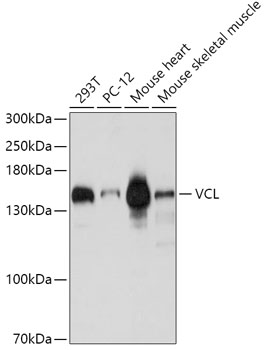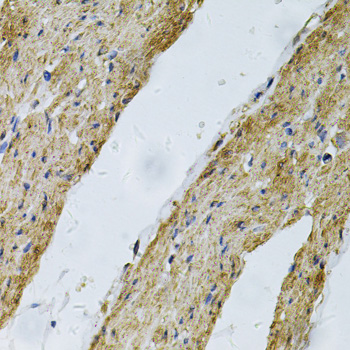Cell Biology Antibodies 7
Anti-VCL Antibody (CAB1758)
- SKU:
- CAB1758
- Product Type:
- Antibody
- Reactivity:
- Human
- Reactivity:
- Mouse
- Reactivity:
- Rat
- Host Species:
- Rabbit
- Isotype:
- IgG
- Antibody Type:
- Polyclonal Antibody
- Research Area:
- Cell Biology
Description
| Antibody Name: | Anti-VCL Antibody |
| Antibody SKU: | CAB1758 |
| Antibody Size: | 20uL, 50uL, 100uL |
| Application: | WB IHC |
| Reactivity: | Human, Mouse, Rat |
| Host Species: | Rabbit |
| Immunogen: | Recombinant fusion protein containing a sequence corresponding to amino acids 767-1066 of human VCL (NP_003364.1). |
| Application: | WB IHC |
| Recommended Dilution: | WB 1:500 - 1:2000 IHC 1:50 - 1:200 |
| Reactivity: | Human, Mouse, Rat |
| Positive Samples: | 293T, PC-12, Mouse heart, Mouse skeletal muscle |
| Immunogen: | Recombinant fusion protein containing a sequence corresponding to amino acids 767-1066 of human VCL (NP_003364.1). |
| Purification Method: | Affinity purification |
| Storage Buffer: | Store at -20'C. Avoid freeze / thaw cycles. Buffer: PBS with 0.02% sodium azide, 50% glycerol, pH7.3. |
| Isotype: | IgG |
| Sequence: | AKRE VENS EDPK FREA VKAA SDEL SKTI SPMV MDAK AVAG NISD PGLQ KSFL DSGY RILG AVAK VREA FQPQ EPDF PPPP PDLE QLRL TDEL APPK PPLP EGEV PPPR PPPP EEKD EEFP EQKA GEVI NQPM MMAA RQLH DEAR KWSS KGND IIAA AKRM ALLM AEMS RLVR GGSG TKRA LIQC AKDI AKAS DEVT RLAK EVAK QCTD KRIR TNLL QVCE RIPT ISTQ LKIL STVK ATML GRTN ISDE ESEQ ATEM LVHN AQNL MQSV KETV REAE AASI KIRT DAGF TLRW VRKT PWYQ |
| Gene ID: | 7414 |
| Uniprot: | P18206 |
| Cellular Location: | Cell junction, Cell membrane, Cytoplasm, Cytoplasmic side, Peripheral membrane protein, adherens junction, cytoskeleton, focal adhesion |
| Calculated MW: | 24kDa/116kDa/123kDa |
| Observed MW: | 140kDa |
| Synonyms: | VCL, CMD1W, CMH15, HEL114, MV, MVCL, vinculin |
| Background: | Vinculin is a cytoskeletal protein associated with cell-cell and cell-matrix junctions, where it is thought to function as one of several interacting proteins involved in anchoring F-actin to the membrane. Defects in VCL are the cause of cardiomyopathy dilated type 1W. Dilated cardiomyopathy is a disorder characterized by ventricular dilation and impaired systolic function, resulting in congestive heart failure and arrhythmia. Multiple alternatively spliced transcript variants have been found for this gene, but the biological validity of some variants has not been determined. |
| UniProt Protein Function: | Vinculin: Actin filament (F-actin)-binding protein involved in cell-matrix adhesion and cell-cell adhesion. Regulates cell- surface E-cadherin expression and potentiates mechanosensing by the E-cadherin complex. May also play important roles in cell morphology and locomotion. Exhibits self-association properties. Interacts with NRAP and SORBS1. Interacts with TLN1. Interacts with SYNM. Interacts with CTNNB1 and this interaction is necessary for its localization to the cell-cell junctions and for its function in regulating cell surface expression of E-cadherin. Metavinculin is muscle-specific. Belongs to the vinculin/alpha-catenin family. 3 isoforms of the human protein are produced by alternative splicing. |
| UniProt Protein Details: | Protein type:Cell adhesion; Cytoskeletal; Motility/polarity/chemotaxis Chromosomal Location of Human Ortholog: 10q22.2 Cellular Component: cytoskeleton; adherens junction; protein complex; cell-cell adherens junction; focal adhesion; costamere; plasma membrane; extracellular region; fascia adherens; intercellular junction; cytosol; vesicle; cell-matrix junction; actin cytoskeleton Molecular Function:protein binding; cadherin binding; beta-catenin binding; structural molecule activity; actin binding; alpha-catenin binding Biological Process: lamellipodium biogenesis; platelet activation; platelet degranulation; apical junction assembly; muscle contraction; axon extension; cell-matrix adhesion; morphogenesis of an epithelium; cell adhesion; cell motility; blood coagulation; negative regulation of cell migration Disease: Cardiomyopathy, Dilated, 1w |
| NCBI Summary: | Vinculin is a cytoskeletal protein associated with cell-cell and cell-matrix junctions, where it is thought to function as one of several interacting proteins involved in anchoring F-actin to the membrane. Defects in VCL are the cause of cardiomyopathy dilated type 1W. Dilated cardiomyopathy is a disorder characterized by ventricular dilation and impaired systolic function, resulting in congestive heart failure and arrhythmia. Multiple alternatively spliced transcript variants have been found for this gene, but the biological validity of some variants has not been determined. [provided by RefSeq, Jul 2008] |
| UniProt Code: | P18206 |
| NCBI GenInfo Identifier: | 21903479 |
| NCBI Gene ID: | 7414 |
| NCBI Accession: | P18206.4 |
| UniProt Secondary Accession: | P18206,Q16450, Q5SWX2, Q7Z3B8, Q8IXU7, |
| UniProt Related Accession: | P18206 |
| Molecular Weight: | 24,904 Da |
| NCBI Full Name: | Vinculin |
| NCBI Synonym Full Names: | vinculin |
| NCBI Official Symbol: | VCL |
| NCBI Official Synonym Symbols: | MV; MVCL; CMD1W; CMH15; HEL114 |
| NCBI Protein Information: | vinculin; metavinculin; epididymis luminal protein 114 |
| UniProt Protein Name: | Vinculin |
| UniProt Synonym Protein Names: | Metavinculin; MV |
| Protein Family: | Vinculin |
| UniProt Gene Name: | VCL |
| UniProt Entry Name: | VINC_HUMAN |








